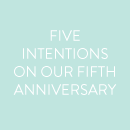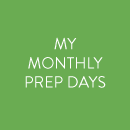How to be a more relational writer
When I wrote my three-part blogging series last year, I promised a fourth post with my best writing tips. This was inspired by a kind reader, who wrote this in a past survey: “You seem to care so much about your readers! How did you get to be so relatable? I think you could be a therapist!”
I’m generally not in the practice of repeating kind things people say about me, but this comment has stuck with me for years.
Because I do care about my readers – very much! But what this comment helped me realize is that not only do I care about my readers, but I’m able to convey that care through my writing. It’s a skill I’m very grateful to have, and one that I’ve honed throughout my life. In the spirit of passing along what I have to offer (which is my heart for showing up here!), I took some time to analyze what, exactly, helps make my writing relatable, relational, and enjoyable to read. We talk about some heightened topics here, and I think it’s in part these tips that allow me to do that in a way that is – and also feels – open, friendly, and welcoming.
Whether you consider yourself a writer or not – whether you have a blog or write for your job or not – whether you write to record your own stories or for an audience – being able to communicate in a way that draws people in is always a good thing. I hope these tips are helpful!

1. Read. A lot.
Perhaps surprisingly, I am the last person you’d want to diagram a sentence or define a past participle. Instead, (almost) everything I know about sentence structure, cadence, and grammar comes not from high school English but from a lifetime of absorbing good writing in book after book after book.
If you consume enough beautiful and skilled writing, all that has been stored up in your brain and heart will eventually start to overflow into what you produce.
2. Choose your topics with care.
I could not write in my preferred style about every topic, and so when I consider writing a post, I ask myself whether I can speak honestly, candidly, and authentically about it. Why do I want to write about this? What’s my motivation? What do I hope to convey? How might I be able to help readers with what I have to share? What unique perspective can I bring to the topic?
Answering these questions helps ensure that not only are my posts technically proficient, but hopefully interesting and edifying for any readers.
3. Strive for precision.
Was it a perfect day? Or was it another kind of day? The poet in me (trained to observe and relate what I notice with details that illuminate) – as well as the Enneagram 5 (lover of exactitude and precision) – ensure that what I share is not only interesting to read (a “perfect” day doesn’t really tell you much, does it?) but also trustworthy.
If generalities read as laziness or sloppiness, precision reads as care – I took the time to find the correct, accurate wording. This doesn’t mean I have to share every detail in every story, but that because what I do share is precise, you can trust it.
4. Look for what might be unintentionally offensive.
Speaking of Enneagram 5s: we are known for being perceptive. This is a quality I surely learned from my Dad, who received his PhD in international diplomacy. I am good at seeing what others might find offensive, the little nuances that either bring someone in or push them away, and I care enough to remove them from my writing as much as possible.
Here’s just one example. In this post, I wrote the line, “I’ve found that it IS possible to think deeply and feel passionately about something without broadcasting my thoughts to the widest possible audience.” In my first draft, that line read, “Contrary to what some people would have you believe, it is possible…” but upon re-read, that seemed needlessly antagonistic (“some people” might make a reader wonder who I’m talking about with thinly-veiled contempt). I then edited it to, “Contrary to what the world would have you believe…” That felt less personal, but in the end, where I landed (turning it back on my own discovery) felt the most neutral.
5. Come back for edits.
I never publish a post the day after I write it. After I get out my first draft, I’ll come back on a second day to read through what I’ve written, adding to it and tweaking sentences for clarity, simplicity, tone, and impact. Returning with fresh eyes helps me catch errors and get to the heart of what I really want to say. If I published first drafts, you’d think I was a very different writer :)

6. Simplify and clarify.
In the editing process, I remove pointless adjectives, words I’ve repeated too close together, and other generally unnecessary words or phrases. I check tenses and agreement. I smooth out phrasing.
All of these things make my writing easier and more enjoyable to consume for the reader. Mistakes are distracting; good grammar helps a reader feel taken care of. As C.S. Lewis put it, “A good shoe is a shoe you don’t notice. Good reading becomes possible when you need not consciously think about eyes, or light, or print, or spelling.” Even if you don’t think of yourself as a grammar connoisseur, your brain will get tripped up by confusing sentences and sloppy punctuation. Over time, you might think less of my ideas or of me as a narrator because of this, even if you couldn’t quite put your finger on why.
7. Begin in medias res.
Chalk this up to one thing I did learn in school! In medias res is Latin for “in the midst of things,” and it’s a technique where the writer begins in the middle of the plot, filling in details gradually. I’m using the term loosely here (my posts are not exactly plot-driven), but what I like about this technique is how it engenders closeness between the writer and her readers. It’s a way to reinforce community.
When I mention “Kate” or “the island” or June’s baking without explanation and you, the reader, know who or what those things are, that reinforces for you that you’re a part of this community. You’re an insider. Writing in this way makes EFM feel more like a continuous conversation between friends than a first meeting with a stranger.
And if you are reading a post and run into something you’re not familiar with, but it feels like you should be, hopefully it makes you want to stick around and explore a bit more! :)
8. Talk tentatively.
This is a big one, and another one I learned from my Dad. Talking tentatively helps to project a blend of confidence and humility – in my case, that I have confidence in what I’m sharing (or else I wouldn’t be sharing it!) and also that I recognize there might be nuances and perspectives I haven’t yet considered.
This might sound like: “it might be helpful to,” “this can be a good way” “you might want to…,” or “I find that…” It also looks like turning from prescriptions towards observations and wisdom earned from personal experience. For example, consider the difference in these three lines:
You should wear a sun hat.
It’s good to wear a sun hat.
I like to wear a sun hat.
Personally, I’d bristle at the first sentence if I read it in a blog post, and I’d side-eye the second. The third makes me lean in – I want to know more. Why, writer, do you like wearing a sun hat? Might I also like wearing a sun hat? Much like whispering when you want a child’s attention instead of yelling, sharing a personal conviction from humility makes others more likely to listen with an open mind.
9. Remember rules are made to be broken.
These rules, yes, but even rules of grammar. When you’ve established a pattern of good grammar, you can break it for emphasis. A run-on sentence can communicate overwhelm or urgency or excitement; a pop culture expression or spelling can help strengthen community (you and your reader are part of the same group if you both understand what’s being said!).
10. Stay humble and curious.
In the end, all of the skill in the world isn’t going to make someone seem caring for long if they don’t actually… care. To be a good writer, you must stay curious: about why things are the way they are, about why people think and act the way they do, about why people care about what they care about. If you ask for your readers’ opinions or thoughts, sit with the answers.
Here’s the good news: I am not a particularly special person, nor even close to the best writer. But this corner and this practice is where I’ve chosen to put in some of my 10,000 hours, and so I hope today’s tips are at least an interesting peek behind the EFM curtain. As always, thank you for being here and for reading my earnestly caring, but always imperfect, writing :) I am grateful for you!
Part One: Nuts and Bolts
Part Two: Content
Part Three: Grab Bag




















Wonderful tips, Emily! As a rule-follower, I used to agonize over breaking certain grammar rules…until I learned in a scientific writing workshop that the only rule should be to prioritize reader comprehension. Sometimes following the rules leads to a sentence structure that is harder for the reader to understand! Now I can break rules guilt-free. : )
Love that, Brooke! And important to remember, too, that context matters so much for the appropriate level of formality! Grammar that is technically correct might come across as off-putting in some more casual contexts, and that’s not always worth the correctness :)
These are gold! So grateful for you!
Ahh thank you, friend! Glad they’re helpful!!
If I were still teaching, I’d use this as a resource on my first day! So good!
That makes my day! I would have looooooved to sit in on one of your classes!!
So many wonderful tips! I’m impressed you were able to pick out such tangible advice from something that, in so many ways, comes incredibly naturally to you. Grateful to have learned so much firsthand over my 10 years of reading your writing :)
That’s probably why it took me 10+ years to get around to writing this post, ha!